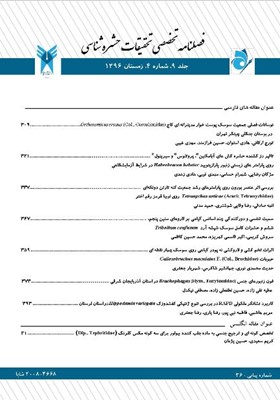اثرات تخمکشی و لاروکشی نه پودر گیاهی روی سوسک چهارنقطهای حبوبات Callosobruchus maculatus F. (Col: Bruchidae)
محورهای موضوعی : حشره شناسی و سایر بندپایانحدیث محمدی نوری 1 , جهانشیر شاکرمی 2 , شهریار جعفری 3
1 - گروه گیاهپزشکی، دانشکده کشاورزی، دانشگاه لرستان، خرم آباد، ایران
2 - گروه گیاه پزشکی، دانشکده کشاورزی، دانشگاه لرستان
3 - گروه حشرهشناسی کشاورزی، دانشکده کشاورزی، دانشگاه لرستان، خرم آباد، ایران
کلید واژه: سمیت تنفسی, fumigant toxicity, سوسک چهارنقطهای حبوبات, Callosobruchus maculatus, حبوبات, Legumes, آفتکش گیاهی, Botanical pesticide,
چکیده مقاله :
در جستجوی ترکیبات آفت کش تجدید شونده و سازگار با محیط زیست، اثر تخم کشی و لاروکشی پودرگیاهان بابونه (Chamaemelum nobilis L.)، بومادران(Achillea millefolium L.)، آویشن وحشی (Thymus serpyllum L.)، پونه(Mentha pulegium L.)، چویل(Ferulago angulate W.)،شوید (Anethum graveolens L.)، دارچین(Cinnamomum zeylanicum L.)، ریحان(Ocimum basilicum L.)و زنجبیل (Zingiber officinale R.) روی سوسک چهارنقطه ای حبوبات(Callosobruchus maculatus F.)مورد بررسی قرار گرفت. آزمایش بر اساس طرح کاملا تصادفی در شرایط دمایی 2±30 درجه سلسیوس، رطوبت نسبی 5±60 درصد و شرایط تاریکی انجام شد. بر اساس نتایج، پودرهای گیاهی مورد مطالعه به طور معنی داری روی سوسک چهارنقطه ای حبوبات اثر تخم کشی و لاروکشی داشتند. بر اساس داده ها در غلظت یک گرم بر 100 گرم بذر، پودر گیاهان زنجبیل، ریحان، آویشن وحشی، دارچین، پونه و بومادران به ترتیب باعث 88، 55/87، 86، 84، 82 و 80 درصد تلفات تخم سوسک چهارنقطه ای حبوبات شدند. نتایج نشان داد که در غلظت یک گرم بر100 گرم بذر، به ترتیب بیشترین اثر لاروکشی مربوط به پودر پونه (77/95 درصد) و بعد از آن ریحان (90درصد)، دارچین (90درصد)، آویشن (86درصد) و بومادران (84درصد) بود. مقادیر LC50 محاسبه شده نشان داد که پودر گیاهان زنجبیل باLC50 برابر با 36/0 گرم بر 100 گرم بذر و پونه با LC50 برابر با 30/0 گرم بر 100 گرم بذر به ترتیب برای کشندگی تخم و لارو سوسک چهارنقطه ای حبوبات موثرتر از دیگر پودرهای گیاهی بوده است. این تحقیق نشان می دهد پودر این گیاهان می تواند به عنوان آفت کش کم خطر و ارزان در مناطق روستایی توصیه شوند.
To search for re-cycleable and environment-friendly pesticides the ovicidal and larvicidal effects of nine botanical powders includingChamomile(Chamaemelum nobilis L.),Yarrow(Achillea millefolium L.),Breckland wild thyme(Thymus serpyllum L.), Squaw mint (Mentha pulegium L.), Ferulago angulata (schlechat.) Boiss,Dill(Anethum graveolens L.),True cinnamon(Cinnamomum zeylanicum L.),Sweet basil (Ocimum basilicum L.)andginger(Zingiber officinal R.)were tested againstCallosobruchus maculates (Fabricius). The experiments were conducted in a completely randomized design at 30±2 °C and 60±5% relative humidity(RH) under dark conditions. Results showed that all tested plant powders had ovicidal and larvicidal effect on C.maculatus. Based on the results in the concentration of 1 g/100g, plant powders of Z. officinal, O. basilicum, T. serpyllum, C. zeylanicum,M. pulegium and A. millefolium caused 88, 87.55, 86, 84, 82 and 80% egg mortalities, respectively. The results showed that in the concentration of 1 g/100g M. pulegium powder represented the most potent efficient larvicidal agent (95.77%) followed by O. basilicum (90%), C. zeylanicum (90%), T. serpyllum (86%) and A. millefolium (84%). Also results indicated thatpowders of Z. officinal (LC50 = 0.36 g/100g) and M. pulegium (LC50 = 0.30 g/100g) had the highest larvicidal and ovicidal activity against C. maculatus, respectively. It was found that these botanical powders can be used as a cheap and safe pesticide to control storage pests in rural areas.
_||_


